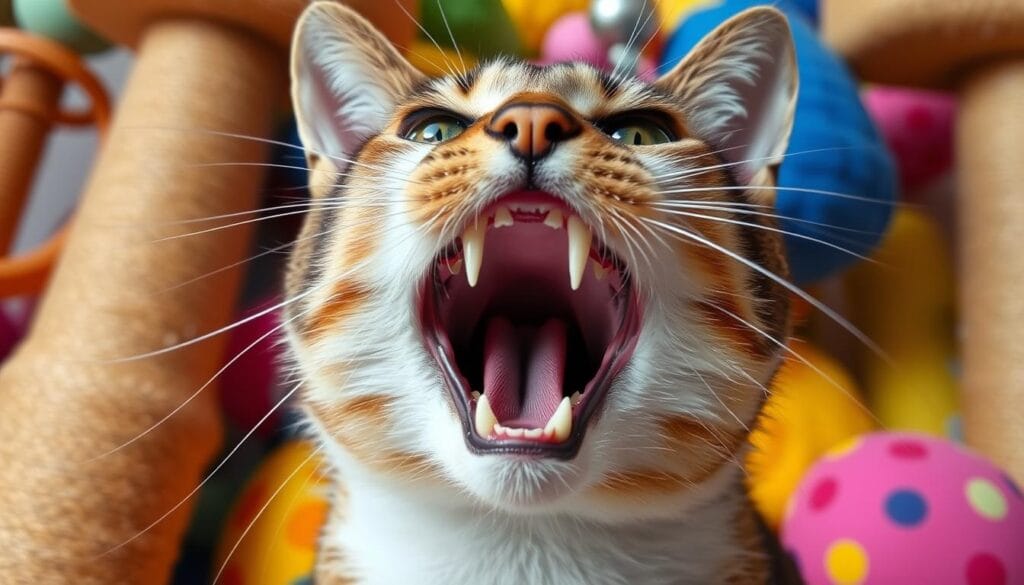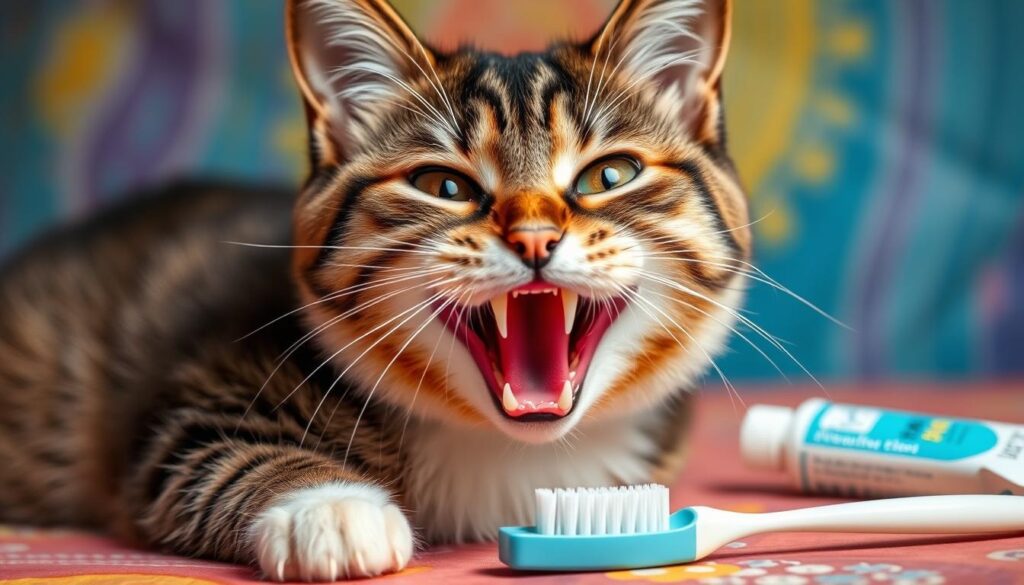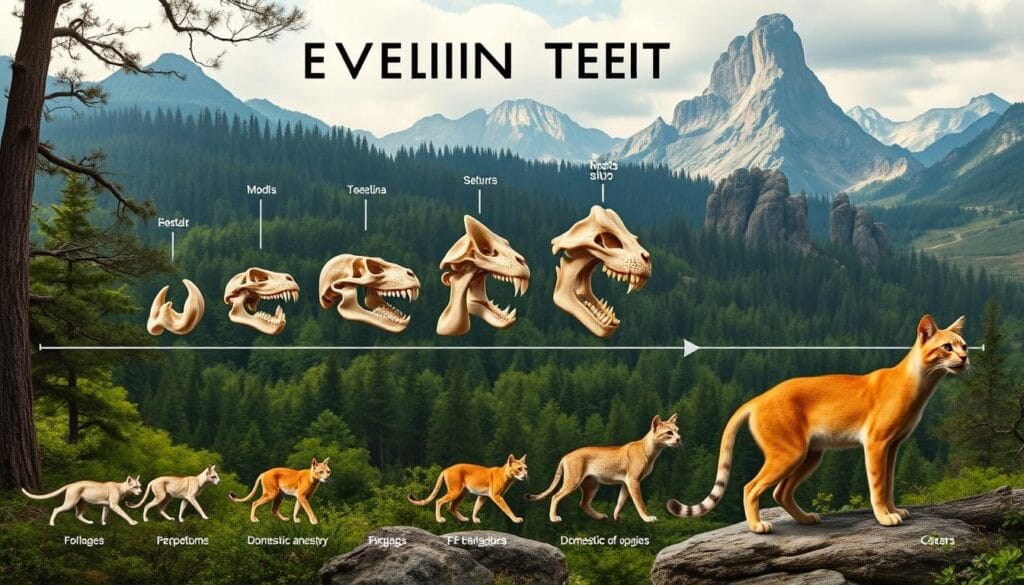
Table of Contents
Ever wonder how many teeth does cat have? You might be surprised to learn that cats have a special set of teeth. These teeth are key to their health and happiness. As a cat owner, knowing about cat teeth and dental health is vital.
With about 90% of cats over 4 having dental issues, it’s crucial to know how to care for their teeth.

Cats have 30 permanent teeth, including incisors, canines, premolars, and molars. But how do these teeth grow, and what dental problems do cats face? Learning about cat teeth helps you understand their dental health better. This knowledge is essential for keeping their teeth healthy and their overall well-being.
Understanding Your Cat’s Dental Structure
As a cat owner, knowing about cat teeth types and their roles is key. The feline dental structure is special and vital for your cat’s health. Cats have incisors, canines, premolars, and molars. Each tooth type serves a specific purpose, like biting, tearing, or grinding.
The cat teeth function is designed for a particular task. Incisors help cut food, while canines tear and pierce. Premolars and molars are for grinding and crushing. Knowing about cat teeth types helps you care for your cat’s teeth better.
Here’s a quick look at the cat teeth types and what they do:
| Tooth Type | Function |
|---|---|
| Incisors | Biting and cutting food |
| Canines | Tearing and piercing |
| Premolars | Grinding and crushing food |
| Molars | Grinding and crushing food |
how many teeth does cat have?
As a cat owner, you might wonder how many teeth does a cat have. Cats have two sets of teeth: deciduous and permanent. Kittens are born without teeth but start getting their baby teeth at 3 weeks. By 6 to 8 weeks, they have 26 baby teeth.
As your cat grows, their baby teeth fall out and are replaced by permanent ones. Adult cats have 30 permanent teeth, including incisors, canines, and molars. The cat teeth number can vary, but 30 is the average for a healthy adult cat. Knowing about feline dental health is key to keeping your cat healthy.
Here are some key facts about cat teeth:
- Kittens have 26 deciduous teeth
- Adult cats have 30 permanent teeth
- Deciduous teeth start to erupt at around 3 weeks of age
- Permanent teeth begin to replace deciduous teeth at around 10 weeks to 6 months of age
Regular mouth checks are vital to watch your cat’s tooth growth and position. By knowing how many teeth does a cat have and caring for their teeth, you can prevent dental issues. This ensures your cat’s feline dental health stays top-notch.
The Development of Your Cat’s Teeth
As a cat owner, it’s key to know about your cat’s teeth development. Kittens start teething at 2-3 weeks old. By 6-7 months, they have all their baby teeth, or kitten teeth. This is vital for their growth.
The feline teething time can be tough for kittens. They might feel pain and discomfort. But, it’s a natural step in their development. It’s important to care for them well during this time. Here are some important facts about your cat’s teeth:
- Kittens have 26 baby teeth, which start coming in at 2-3 weeks.
- Adult cats have 30 permanent teeth, which start coming in at 3-4 months.
- The cat dental formula includes 12 incisors, 4 canines, 10 premolars, and 4 molars.
Knowing about your cat’s teeth development is key for their care. Regular vet visits and a balanced diet can help avoid dental issues. This ensures your cat stays healthy and happy.
| Age | Teeth Development |
|---|---|
| 2-3 weeks | Kittens start teething |
| 6-7 months | Kittens have a full set of deciduous teeth |
| 3-4 months | Adult teeth start to emerge |
The Anatomy of Cat Teeth
Understanding the cat teeth anatomy is key to knowing your cat’s dental structure. Cats have 30 adult teeth, split into incisors, canines, premolars, and molars. Each type of tooth has a special job.
The tooth structure of a cat’s teeth is made for biting, tearing, and grinding food. Incisors help with biting and cutting. Canines are for piercing and holding onto prey. Premolars and molars are for grinding and crushing food. Each tooth has a unique root system, with incisors having one root and premolars and molars having two to three.
Here are some key features of a cat’s teeth:
- Incisors: 12 teeth, used for biting and cutting
- Canines: 4 teeth, used for piercing and holding prey
- Premolars: 10 teeth, used for grinding and crushing food
- Molars: 4 teeth, used for grinding and crushing food
| Type of Tooth | Number of Teeth | Function |
|---|---|---|
| Incisors | 12 | Biting and cutting |
| Canines | 4 | Piercing and holding prey |
| Premolars | 10 | Grinding and crushing food |
| Molars | 4 | Grinding and crushing food |
Common Dental Issues in Cats
As a cat owner, knowing about common dental issues is key. These issues can range from mild to severe and might need vet care. Keeping your cat’s dental health in check is vital to avoid bigger health problems.
Common dental issues include periodontal disease, tooth resorption, and oral tumors. These can cause pain and make eating hard. Regular dental check-ups with your vet are important for catching problems early.
Signs of Dental Problems
Spotting dental problems in cats is crucial for quick treatment. Look out for bad breath, swollen gums, and loose teeth. If you see these signs, talk to your vet right away.
Prevention Methods
To prevent dental issues, regular dental care is a must. Brush your cat’s teeth and feed a balanced diet that’s good for their teeth. Dry kibble helps remove plaque and tartar, lowering dental problem risks.
When to See a Veterinarian
If you think your cat has dental problems, see a vet. They can check your cat’s teeth and suggest the right treatment. Regular vet visits can prevent serious health issues linked to bad dental health.
| Dental Issue | Description | Treatment |
|---|---|---|
| Periodontal Disease | Inflammation of the gums and supporting tissues | Veterinary dental cleaning and antibiotics |
| Tooth Resorption | Loss of tooth structure | Extraction of affected tooth |
| Oral Tumors | Growth of abnormal cells in the mouth | Surgery, radiation, or chemotherapy |
Maintaining Your Cat’s Dental Health
As a cat owner, you are key to keeping your cat’s teeth healthy. Regular brushing and vet visits are vital. Feline dental care keeps teeth clean and prevents diseases.
The American Animal Hospital Association says vet dental checks catch problems early. Dental maintenance is crucial for cats, as they often get dental diseases. These can lead to serious health issues if not treated.
Here are some tips for your cat’s dental health:
- Brush your cat’s teeth regularly to stop plaque and tartar buildup
- Give your cat a balanced diet with high-quality kibble
- Make sure to schedule regular vet dental check-ups

By following these tips, you can prevent dental problems. This ensures your cat stays happy and healthy. Remember, feline dental care needs ongoing attention to keep your cat healthy.
Regular dental maintenance also stops bad breath and eating troubles. These are signs of dental issues in cats. Working with your vet and sticking to a dental care routine keeps your cat’s teeth clean. This prevents severe dental problems.
What Your Cat’s Teeth Tell You About Their Health
As a cat owner, you might not know that your cat’s teeth can tell you a lot about their health. Cat teeth health is key to their dental health. By looking at your cat’s teeth, you can spot health problems early.
For example, tartar buildup, gum inflammation, or tooth decay show poor dental health. The color, shape, and alignment of your cat’s teeth also hint at their health. Watching these signs helps you keep your cat’s mouth healthy and avoid bigger problems.
Age Indicators
Cat teeth can also tell you about a cat’s age. As cats grow, their teeth change. By checking their teeth, you can guess their age. Kittens have 26 baby teeth by 2 months, which grow to 30 adult teeth.
Health Markers
Some health issues, like FORLs and SCC, can affect your cat’s teeth and health. Signs like too much saliva, bleeding gums, or trouble eating mean you should see a vet fast.
Regular dental checks and a good diet keep your cat’s mouth healthy. This helps prevent problems and keeps your cat happy and healthy.
| Condition | Signs | Treatment |
|---|---|---|
| FORLs | Excessive salivation, bleeding from the gums, difficulty eating | Veterinary care, dental surgery |
| SCC | Oral tumors, weight loss, salivation, difficulty swallowing | Veterinary care, surgery, radiation therapy |
The Evolution of Feline Teeth
The feline teeth evolution is quite interesting. Domestic cats have 30 teeth, including 12 incisors, 4 canines, 10 premolars, and 4 molars. In contrast, wild cat teeth have changed to fit different diets and places. For instance, adult lions can have canines up to 8 cm long. Saber-toothed cats like Homotherium latidens lived about 1.0 million years ago.
Wild Cat Comparisons
Wild cat teeth have become more specialized than domestic cats’. Some main differences are:
- Adult lions have bigger canines than domestic cats
- Saber-toothed cats had bigger, more specialized canines for a “shearing bite”
- Cheetahs eat bones of small prey and parts of bigger prey
Evolutionary Adaptations
The evolutionary adaptations of feline teeth have helped them survive in various places. For example, modern cats mainly slice through meat. This is different from dogs, which can slice and crush. The feline teeth evolution has also led to unique dental features, like the canine teeth for piercing prey.

The Role of Diet in Dental Health
As a cat owner, you have a big role in keeping your cat’s teeth healthy. A good cat diet dental health is key to avoiding dental diseases. The food your cat eats can either help or harm their teeth.
A diet high in sugar and carbs can lead to plaque and tartar. This can cause gingivitis and other dental problems.
A balanced feline nutrition plan should include foods that help clean your cat’s teeth. Some foods and treats are made to promote dental health. They have the Veterinary Oral Health Council (VOHC) seal of approval.
Important nutrients for your cat’s dental health include zinc, polyphosphates, and ascorbic acid (vitamin C). These help reduce inflammation, promote healing, and prevent plaque and tartar. Feeding your cat a balanced diet with these nutrients can keep their teeth and gums healthy.
While diet is important, it’s not the only thing. Regular tooth brushing and vet check-ups are also crucial. By combining a balanced diet with good oral hygiene, you can keep your cat’s teeth and gums healthy for years.
Conclusion: Understanding Your Cat’s Dental Needs
Understanding your cat’s dental needs is key to their health. How many teeth does a cat have? Adult cats have 30 permanent teeth, and kittens go through teething. This shows how important feline dental care is.
Regular vet visits, a balanced diet, and good dental hygiene are crucial. They help prevent dental disease, which affects up to 70% of cats over 3. Watching your cat’s teeth and gums closely can help spot problems early.
Your cat’s dental health is linked to their overall health. So, taking care of their teeth is vital. With the right care, your cat can have a healthy, happy smile for many years.
FAQ: How Many Teeth Does Cat Have?
How many teeth does a cat have?
An adult cat has 30 teeth, while kittens have 26 baby teeth that are eventually replaced by permanent teeth.
At what age do kittens get their teeth?
Kittens begin developing teeth at 2 to 4 weeks old, and their full set of baby teeth usually appears by 8 weeks.
When do kittens lose their baby teeth?
Kittens start losing their baby teeth around 3 to 4 months old, and by 6 months, they should have their full set of 30 adult teeth.
What types of teeth do cats have?
Cats have 12 incisors, 4 canines, 10 premolars, and 4 molars, each serving different purposes like biting, tearing, and chewing.
How can I tell if my cat has dental problems?
Signs of dental issues include bad breath, drooling, difficulty eating, swollen gums, and pawing at the mouth. Regular vet check-ups help prevent serious conditions.
Do cats need dental care?
Yes, cats require regular dental care, including brushing, dental treats, and professional cleanings, to prevent gingivitis, tartar buildup, and tooth loss.
Can cats lose their teeth as they age?
Yes, older cats may lose teeth due to gum disease, tooth decay, or injury. Regular dental care can help maintain their oral health.
What should I do if my cat loses a tooth?
If an adult cat loses a tooth, consult a veterinarian. It may indicate dental disease or trauma, requiring medical attention.
Do cats experience pain when teething?
Yes, kittens may experience mild discomfort, drooling, and chewing on objects while teething. Providing soft toys and wet food can help ease their discomfort.
Source Links
- 5 Interesting Facts About Cat Teeth You Should Know – https://www.pawlicy.com/blog/cat-teeth-facts/
- 9 Interesting Facts About Cat Teeth – https://www.petmd.com/cat/care/9-interesting-facts-about-cat-teeth
- Cat Teeth: 5 Facts You Should Know | Great Pet Care – https://www.greatpetcare.com/wellness/cat-teeth-facts-you-should-know/
- How Many Teeth Do Cats Have? A Guide to Your Cat’s Dental Health – https://www.thedoorbuddy.com/blogs/door-buddy/how-many-teeth-do-cats-have?srsltid=AfmBOorfJoE-Q64GbbUW40l2ZtiX0wzc5i332qOImj_tP1w7HKCw94fK
- How Many Teeth Do Cats Have And How Do I Care For Them? – https://basepaws.com/blog/how-many-teeth-do-cats-have-and-how-do-i-care-for-them?srsltid=AfmBOooB36Kjt6HdNQ9OMYTEThup9_s1BoV8frcgVvtKzJx7oPanKepf
- Teeth Count in Pets: How Many Do They Have? – https://missoulavetdentist.com/how-many-teeth-does-my-pet-have/
- Cat Tooth Loss: How to Care for Them – https://www.wellpets.com/blog/105-caring-for-a-cat-with-few-or-no-teeth/
- Persistent Deciduous Teeth (Baby Teeth) in Cats | VCA Animal Hospitals – https://vcahospitals.com/know-your-pet/retained-deciduous-teeth-baby-teeth-in-cats
- How Many Teeth Do Cats Have? The Mystery of Feline Teeth – https://www.boredpanda.com/pet-wellness/cat/how-many-teeth-do-cats-have/
- How Many Teeth Do Cats Have? – https://www.uahpet.com/blogs/hydration-health/how-many-teeth-do-cats-have?srsltid=AfmBOooL4yKV2_ky_bK9o45lH00f20binIPwjnCR8hNXX7Ms4FULs5X8
- Feline Dental Anatomy | Feline Teeth & Types of Cat’s Teeth | AnatomyStuff – https://free-resources.anatomystuff.co.uk/feline-dental-anatomy-free-downloads/
- How many teeth do cats have? – https://www.myfamilyvets.co.uk/how-many-teeth-do-cats-have
- How Many Teeth Does My Young Cat Have? – https://vcahospitals.com/pediatric/kitten/health-wellness/how-many-teeth-does-my-cat-have
- Dr. Ernie’s Top 10 Cat Dental Questions… And His Answers! – https://www.pethealthnetwork.com/cat-health/cat-checkups-preventive-care/dr-ernies-top-10-cat-dental-questions-and-his-answers
- Evolution of felid teeth – https://www.mun.ca/biology/scarr/4505_Felid_Teeth.htm
- How Many Teeth Does a Cat Have? Vet-Approved Facts & Infographic – Catster – https://www.catster.com/cat-health-care/how-many-teeth-does-a-cat-have/
- Atlantic Coast Veterinary Conference 2001 – https://www.vin.com/apputil/content/defaultadv1.aspx?pId=11131&id=3844125&print=1
- Diet and Dental Health in Cats – https://www.petmd.com/blogs/nutritionnuggets/cat/jcoates/2013/june/cats-and-dental-health-30448
- Dental health diets for cats – https://en.wikipedia.org/wiki/Dental_health_diets_for_cats
- Understanding Cat Dental Health: How Many Teeth Do Cats Have? – Emergency Dentist Winnipeg – https://emergencydentistwinnipeg.ca/blog/how-many-teeth-do-cats-have/
- How Many Teeth Do Cats Have? – https://petcube.com/blog/how-many-teeth-do-cats-have/
- How Many Teeth Do Cats Have? A Guide to Your Cat’s Dental Health – https://www.thedoorbuddy.com/blogs/door-buddy/how-many-teeth-do-cats-have?srsltid=AfmBOorGEpW3nUUkKYiymNezl_yXsdg5LNs3rxrUJbVbrq1TlUBnl3Sc







